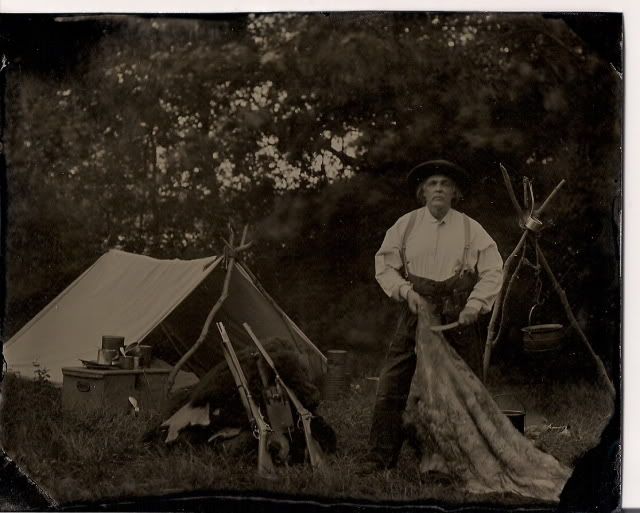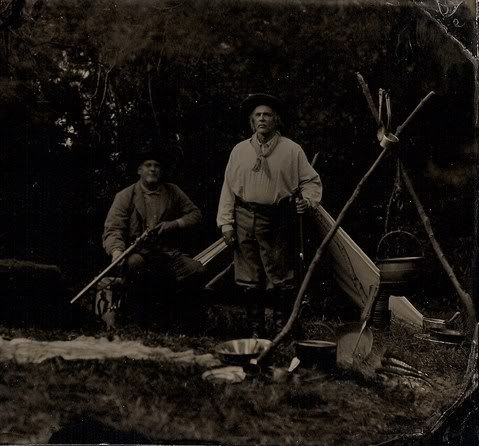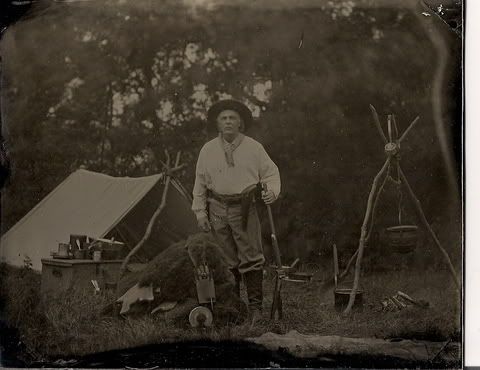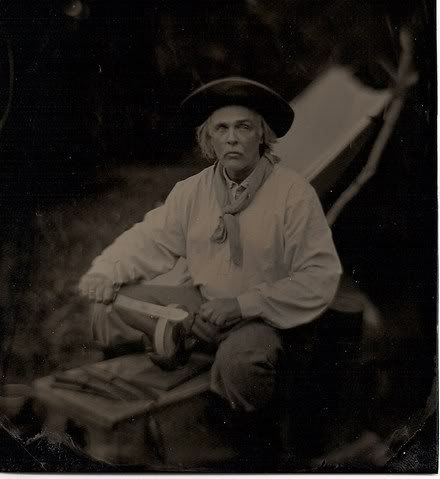Page 1 of 5
Buffalo camp - wet plate photos
Posted: Sat Sep 18, 2010 6:27 pm
by James Hunt
Posted: Sat Sep 18, 2010 6:40 pm
by Stephen Borud
James
That is wicked, nice work.
Stephen Borud
Posted: Sat Sep 18, 2010 6:41 pm
by hotshoe
very cool . Thanks for posting
Posted: Sat Sep 18, 2010 6:41 pm
by powderburner
Totally awsome ,, wow.
Dean
Posted: Sat Sep 18, 2010 7:39 pm
by Macon Due
Are 'wet plates' like tin types........always backward?
Macon
Posted: Sat Sep 18, 2010 9:33 pm
by James Hunt
These are tin types, you see the reverse image. This is the exact same process as one done during the civil war. The chemistry requires development within 5 minutes or so of exposure. It was not until about the 1880's that jell plate came along, used on glass it allowed development at a later time.
Posted: Sat Sep 18, 2010 10:11 pm
by Clark B
The
Daguerreotype, 1837, is formed by the amalgam, or alloy, of mercury and silver. Developed on plate that consists of a copper plate with a thin coating of silver.
The
calotype, introduced in 1841; a negative-positive process using a paper negative.
The
collodion wet plate process, introduced in 1851; a negative-positive process using silver salt impregnated collodion poured from a bottle onto a glass plate.
The
ambrotype, introduced in 1854; a positive-appearing negative image on glass with a black paper backing.
The
tintype or ferrotype, introduced in 1856; a positive-appearing negative image on an opaque metal plate.
The full text here.
http://en.wikipedia.org/wiki/Daguerreotype
Posted: Sat Sep 18, 2010 10:18 pm
by pete
Very, very cool. The photo process is obviously the real deal and the clothing and poses are well done too. I've dressed in my period style clothes and played around with the digital and sepia thing but the real deal definately has that unique, mysterious almost ghostly look. Thanks for the photos.
Posted: Sun Sep 19, 2010 3:39 am
by Woody
Good stuff.
Woody
Posted: Sun Sep 19, 2010 10:29 am
by James Hunt
Way off the purpose of this board, but if you are interested:
We are so used to looking at history in a certain way - when we see it otherwise it doesn't look right. This is what the eye would have seen in 1872.
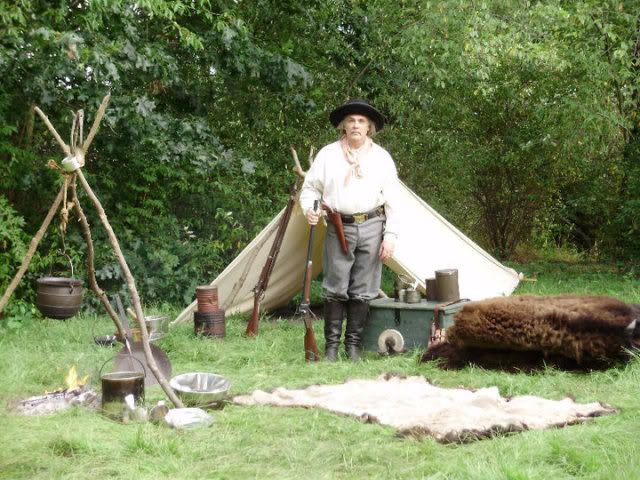
Does not look right does it. I also have fooled around with BW and sepia, but it does not have that spooky depth that period images had. Actually, scanning in these tin types destroys much of that. The actual image is much more impressive with a depth of field that just does not seem possible, particularly with digital work.
The camera:
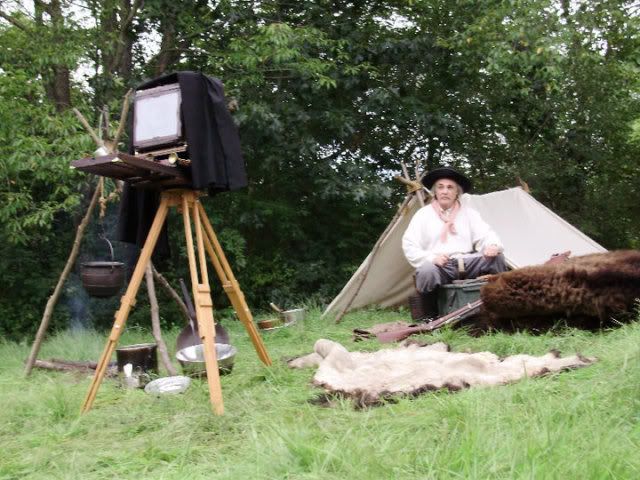
Again, compare me here with the color image above, sort of eerie isn't it?
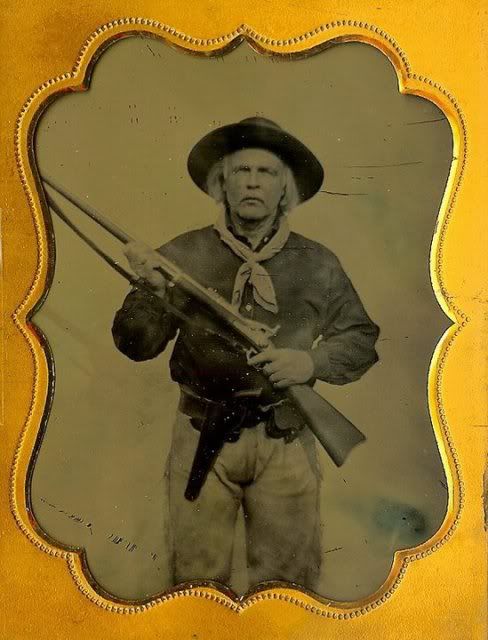
Posted: Sun Sep 19, 2010 10:33 am
by boge
James, great stuff!! However, we can always expect as such from a hardcore NCOWS member who does things right!

Is that Monterrey Jack with you in the photo?
Posted: Sun Sep 19, 2010 10:45 am
by James Hunt
Wow, I am found out. Yes that is Greg Schultz, in fact he is the photographer. He has spent the last two years researching this technique and putting together the camera, the hard part I am told is the lenses which must all be period as no one makes them anymore. There are but a few people in the country doing this. He does not do it commercially, an engineer in real life it is a hobby.
Thanks for the complement regarding doing it right. Curiosity as to what it must have been like to suffer the way these guy's did on the American plains is a motivating factor. For us urban folks it makes stopping for your morning latte on the way into work seem pretty wimpy.
Posted: Sun Sep 19, 2010 11:12 am
by Orville
Nice job. Putting a camp together like that helps one understand what it was really like.
Posted: Sun Sep 19, 2010 4:34 pm
by Clarence
James,
I'm interested in the exposure time. From the movement of the leaves and the apparent blink of the ey in one photo, the lens obviously has a pretty high f-stop.
I wonder if the results we get from modern cameras would look closer to those taken by the tintype camera if we would duplicate the f-stop, which is what controls the depth of field.
Clarence
Posted: Sun Sep 19, 2010 6:07 pm
by James Hunt
As I recall, the exposure time varied from about 8 seconds to 13 seconds dependent upon the cloud cover vs sun out situation.
There is no light meter for this stuff, it is solely dependent upon the photographer's experience, as it was during the period. Not to mention the alchemy involved in preparing the chemicals which will also cause the time to vary. Greg is getting awfully good at this stuff. He took one test shot and was then good to go, and never really had to repeat a shot. Always guessing the exposure time.
Also, I have noticed that using a digital camera, resulting in a color photo, and then converting it to BW / sepia does not get the same extreme in tone that working with actual BW film does.
And also again, note the image of knife sharpening. That was shot with a portrait lens. My face is in focus but the farther out from the center you get the more out of focus things become. Interesting, explains a lot of the period close ups you see.
